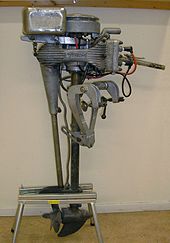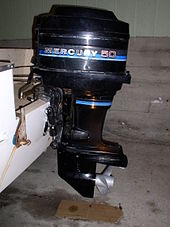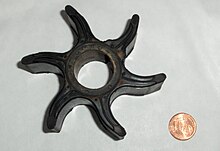
An electric boat is a powered watercraft driven by electric motors, which are powered by either on-board battery packs, solar panels or generators.

A two-strokeengine is a type of internal combustion engine that completes a power cycle with two strokes of the piston in one revolution of the crankshaft. A four-stroke engine requires four strokes of the piston to complete a power cycle in two crankshaft revolutions. In a two-stroke engine, the end of the combustion stroke and the beginning of the compression stroke happen simultaneously, with the intake and exhaust functions occurring at the same time.
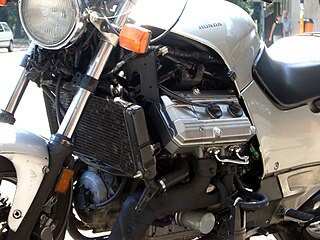
A V4 engine is a four-cylinder piston engine where the cylinders share a common crankshaft and are arranged in a V configuration.

A straight-twin engine, also known as an inline-twin, vertical-twin, or parallel-twin, is a two-cylinder piston engine whose cylinders are arranged in a line along a common crankshaft.

A runabout is any small motorboat holding between four and eight people, well suited to moving about on the water. Characteristically between 20' and 35' in length, runabouts are used for pleasure activities like boating, fishing, and water skiing, as a ship's tender for larger vessels, or in racing. Some common runabout types are bow rider, center console, cuddy boat and walkaround. The world's largest runabout, Pardon Me, is 48 feet long and owned by the Antique Boat Museum in Clayton, New York.
Yamaha Motor Co., Ltd. is a Japanese mobility manufacturer that produces motorcycles, motorboats, outboard motors, and other motorized products. The company was established in the year 1955 upon separation from Nippon Gakki Co., Ltd. and is headquartered in Iwata, Shizuoka, Japan. The company conducts development, production and marketing operations through 109 consolidated subsidiaries as of 2012.

A motorboat, speedboat or powerboat is a boat that is exclusively powered by an engine.
A trolling motor is a self-contained marine propulsion unit that includes an electric motor, propeller and control system, and is affixed to an angler's boat, either at the bow or stern. A gasoline-powered outboard used in trolling, if it is not the vessel's primary source of propulsion, may also be referred to as a trolling motor. The main function of trolling motors was once to keep the boat running at a consistent, low speed suitable for trolling, but that function has been augmented by GPS-tracking trolling motors that function as "virtual anchors" to automatically maintain a boat's position relative to a desired location, such as a favorite fishing spot. Trolling motors are often lifted from the water to reduce drag when the boat's primary engine is in operation.
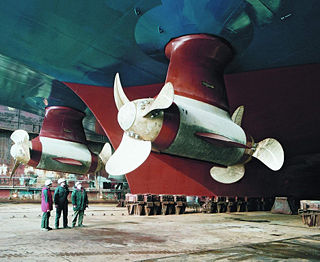
An azimuth thruster is a configuration of marine propellers placed in pods that can be rotated to any horizontal angle (azimuth), making a rudder redundant. These give ships better maneuverability than a fixed propeller and rudder system.
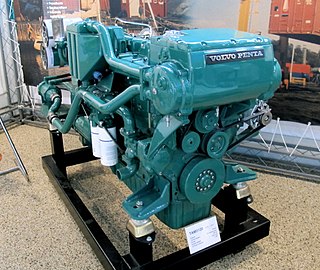
Volvo Penta is a Swedish marine and industrial engine manufacturer, a joint stock company within the Volvo Group. Volvo Penta was founded as Penta in 1907 with the production of its first marine engine, the B1. The Penta company soon became an established internal combustion engine manufacturer, which in 1927 delivered the engine for Volvo's first passenger car.

The Zodiac Milpro Futura Commando 470 or in short FC470 Combat Rubber Raiding Craft (CRRC), also known as the "Combat Rubber Reconnaissance Craft," is a specially fabricated rubber inflatable boat often used by the U.S. Navy, U.S. Marine Corps, the U.S. Army, and others. The CRRC is typically called "Zodiac," referring to the boat's manufacturer, Zodiac Milpro.

A saildrive is a transmission system for a boat whose inboard engine has a horizontal output shaft. The saildrive's input shaft is therefore also horizontal. That input shaft is geared so as to drive a vertical intermediate shaft extending downward through the hull. The intermediate shaft is then geared so as to drive a horizontal propeller shaft mounted on a skeg outside the hull.

Evinrude Outboard Motors was a North American company that built a major brand of two-stroke outboard motors for boats. Founded by Ole Evinrude in Milwaukee, Wisconsin in 1907, it was formerly owned by the publicly traded Outboard Marine Corporation (OMC) since 1935 but OMC filed for bankruptcy in 2000. It was working as a subsidiary of Canadian Multinational Bombardier Recreational Products but was discontinued in May of 2020.

Outboard Marine Corporation (OMC) was a maker of Evinrude, Johnson and Gale Outboard Motors, and many different brands of boats. It was a multibillion-dollar Fortune 500 corporation. Evinrude began in Milwaukee, Wisconsin in 1907. OMC was based in Waukegan, Illinois. They also owned several lines of boats such as Chris Craft, Lowe Boats, Princecraft, Four Winns, SeaSwirl, Stratos, and Javelin. OMC was also a parent company to Lawn-Boy and Ryan, which made lawn mowers.

Mercury Marine is a marine engine division of Brunswick Corporation headquartered in Fond du Lac, Wisconsin. The main product line is outboard engines. It also produces the MerCruiser line of sterndrives and inboard engines. As well as an all new lineup of electric outboard motors utilizing 48V lithium-ion modular and portable designed batteries. Implementing an industry-first transverse flux motor technology, yielding high torque with optimum efficiency. Some manufacturing is in Fond du Lac, while 40-60 HP engines are made in China. Smaller engines are Tohatsus that have been rebadged.
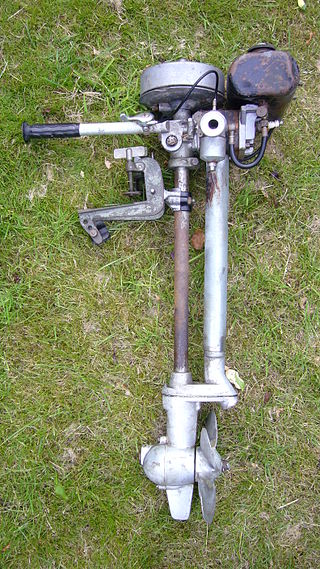
The British Seagull was a British manufacturer of two-stroke outboard engines in Poole, Dorset from the late 1930s until the mid-1990s. Although their "Classic" engines were for decades an exemplar of rugged simplicity and reliability, the company eventually failed when customer tastes changed and as tighter emissions regulations took effect. Production of complete engines stopped in 1996, and another company bought the rights to the brand in 1999. Spare parts continue to be produced for existing engines.

A sterndrive or inboard/outboard drive (I/O) is a form of marine propulsion which combines inboard power with outboard drive. The engine sits just forward of the transom while the drive unit lies outside the hull.
Tohatsu Corporation, previously Tokyo Hatsudoki Company, is a Japanese company manufacturing and selling outboard motors, pleasure boats, portable fire pumps, small fire trucks, pumps for construction and drainage, and refrigeration units for transportation. It also does real estate property management in Japan.

Marine propulsion is the mechanism or system used to generate thrust to move a watercraft through water. While paddles and sails are still used on some smaller boats, most modern ships are propelled by mechanical systems consisting of an electric motor or internal combustion engine driving a propeller, or less frequently, in pump-jets, an impeller. Marine engineering is the discipline concerned with the engineering design process of marine propulsion systems.
A "forward drive" is a form of marine propulsion that uses forward-facing counter-rotating props to pull the boat through water rather than pushing it, with an undisturbed water flow to the propellers. The engine sits just forward of the transom while the drive unit lies outside the hull.

